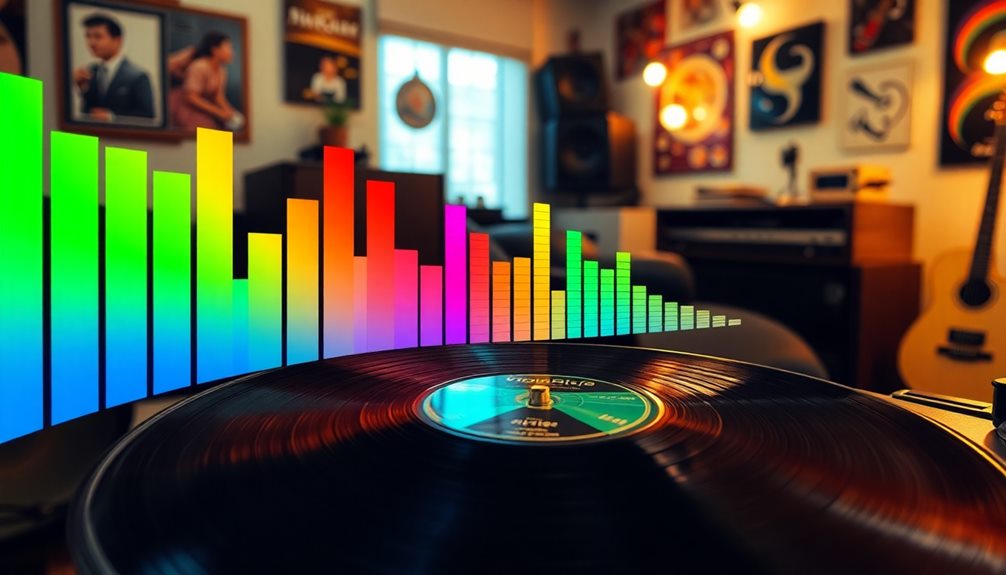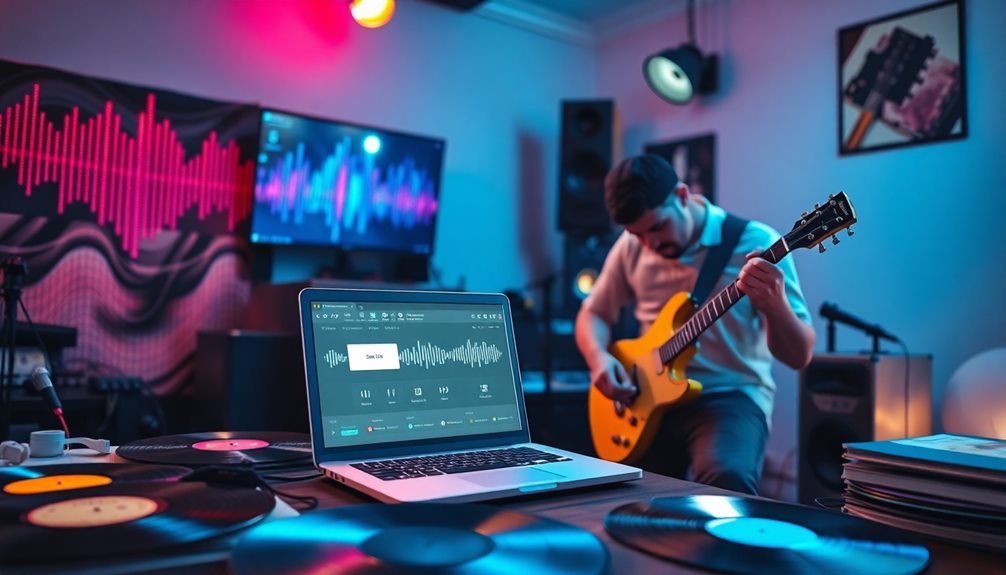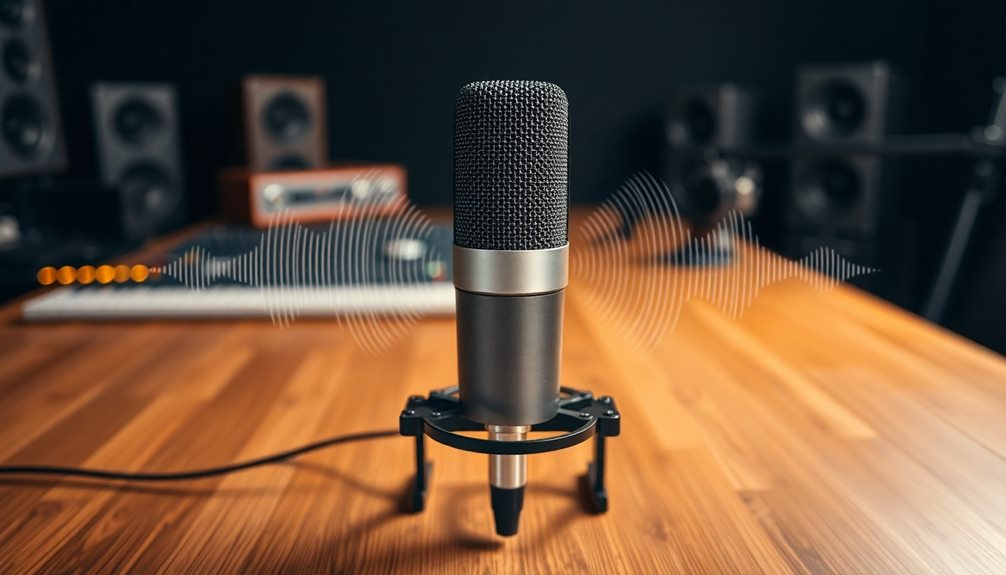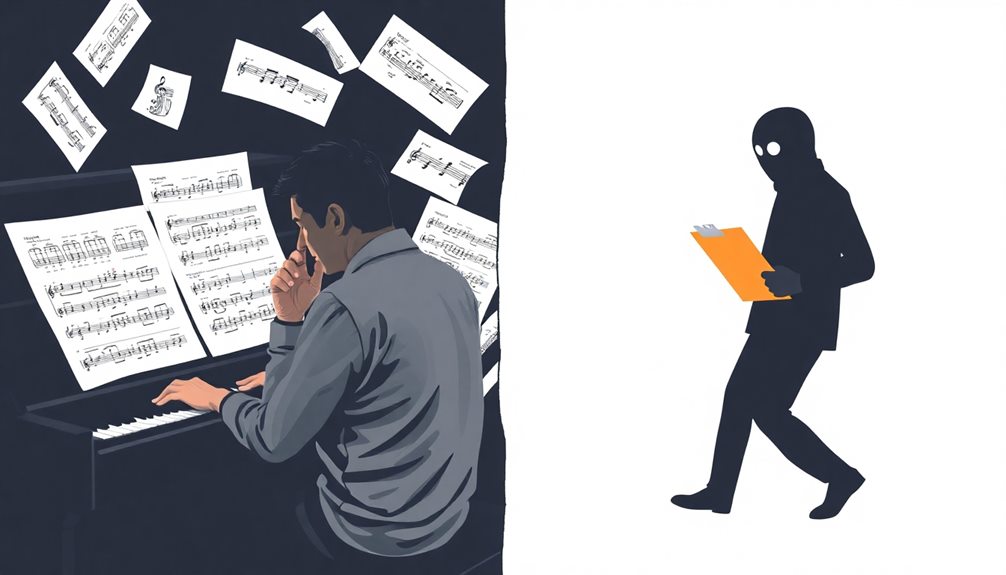The Fletcher-Munson Effect shows why your music can sound different depending on how loud it is or what frequencies you're listening to. Your ears hear certain sounds, especially between 2 kHz and 4 kHz, more clearly. This means that when music plays louder, you might notice the bass and treble more than before. Lower sounds need extra power to seem just as loud, which can change how a song feels. Understanding this effect can help you mix music better or even choose the right volume at home. If you stick around, you'll discover even more about music and sound!
Key Takeaways
- The Fletcher-Munson effect explains how our ears perceive loudness differently at various frequencies, impacting overall sound clarity.
- Sensitivity peaks between 2 kHz and 4 kHz make these frequencies crucial for understanding speech and enhancing vocal clarity in music.
- Low frequencies require significantly more power to achieve equal loudness, influencing mix strategies and the balance of sound elements.
- Volume levels play a critical role; mixing at 90 dB SPL promotes tonal balance and helps avoid overpowering mid-range frequencies.
- Listening environments affect perceived loudness; adjustments are necessary for clarity in different settings like homes, clubs, or outdoor events.
Understanding the Fletcher-Munson Curve
Have you ever wondered why certain sounds seem louder than others, even when they're played at the same volume? You might be surprised to learn that it's all about the Fletcher Munson curve! Developed in the 1930s, this important concept shows how our ears perceive loudness differently across various frequencies.
Imagine listening to music. The Fletcher Munson curve reveals that our ears are most sensitive to sounds between 2kHz and 4kHz. This means these mid-range frequencies feel louder than lower or higher sounds, even if they're at the same sound level. For instance, to hear a low 30 Hz sound as loud as a 1,000 Hz sound, you'd need about 19 dB more power!
The curve's fancy lines, called equal-loudness contours, help us understand this better. Each line shows how much sound pressure is needed for different frequencies to be perceived as equally loud.
Knowing about the Fletcher Munson curve is super helpful for audio engineers! It helps them mix and master music so that everything sounds balanced and enjoyable.
How Frequency Affects Loudness

Understanding how frequency affects loudness is vital for anyone working with sound. You might be surprised to learn that your ears don't hear all frequencies equally! The Fletcher-Munson curve shows us how our perception of loudness changes with different frequencies.
Notably, just like selecting the right cold medications can impact your health, understanding sound frequency can greatly influence your auditory experience.
Here's a quick look at some key points:
- Lower frequencies, like 30 Hz, need about 19 dB more power than a 1,000 Hz tone to sound equally loud.
- Our ears are most sensitive to sounds between 2 kHz and 4 kHz, which are essential for understanding speech.
- At lower volumes, mid-range sounds seem louder than lows and highs, but this shifts at higher volumes.
- Everyone's hearing is a bit different, and so is their playback system. This can change how you perceive loudness!
Mixing Techniques for Better Sound
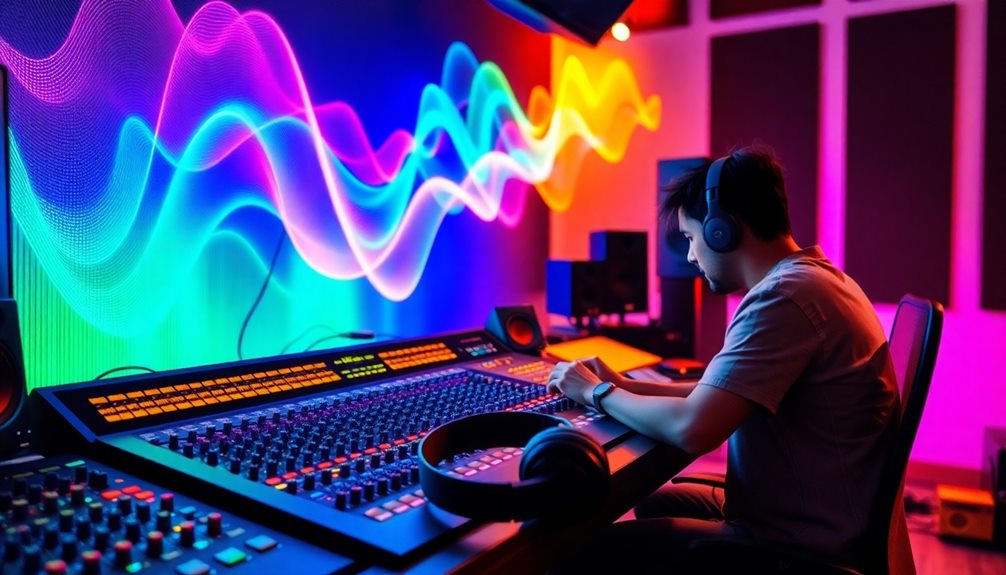
When you mix your sounds, it's super important to pay attention to how different frequencies work together.
The integration of advanced technology, like Snapdragon 8 Gen 3, enhances the mobile audio experience, making it essential to utilize these tools for ideal sound quality.
Keeping elements like vocals clear and balanced can make your music come alive!
Plus, thinking about the volume while mixing helps everything sound great, no matter how loud or soft you play it.
Frequency Awareness in Mixing
To achieve a well-balanced mix, you need to be mindful of how frequency perception affects your sound. Understanding the Fletcher-Munson curve can really help you create a better mix.
Here are four key points to take into account:
- Focus on Vocals and Snares: These elements usually sit in the 2 kHz to 4 kHz range. Make sure they don't overpower other sounds!
- Mix at the Right Volume: Mixing around 90 dBSPL helps balance loudness across the frequency range. Lower volumes can mess with your perception of mid-range sounds.
- Monitor Your Levels: Use a decibel meter or an app to keep track of your sound levels. This prevents ear fatigue and helps you stick to those important guidelines.
- Balance Bass Elements: Remember that lower frequencies need more power to be heard. Pay special attention to how loud your bass sounds compared to other elements.
Balancing Elements for Clarity
Achieving clarity in your mix hinges on how well you balance the various elements. You need to be aware of the Fletcher-Munson curve, which shows that our ears pick up certain frequencies better than others. Frequencies between 2kHz and 4kHz can easily overpower other sounds if you're not careful.
That's why it's important to give each element, like vocals and snares, enough space in your mix. They often sit in the sensitive ranges highlighted by the equal loudness contours. To enhance your mixing skills, consider exploring advanced mixing techniques that can provide deeper insights into achieving a professional sound.
One great technique is using subtractive EQ. This helps reduce masking effects, allowing each sound to shine on its own. When you do this, every element becomes clearer, making your mix more enjoyable to listen to.
Don't forget to check your mix at different volume levels, too! This can reveal how loudness changes can affect what you hear.
Volume Considerations During Mixing
Often, mixing at various volume levels can greatly impact how your track is perceived. The Fletcher-Munson effect shows that our ears hear different frequencies better at different volumes. Here are some key points to take into account while mixing:
- Mix at 90 dB SPL: This level helps you maintain tonal balance and keeps mid-range frequencies clear.
- Watch Out for Mid-Range: Frequencies around 2 kHz to 4 kHz, like vocals and snares, need special attention. They can easily overpower your mix if you're not careful.
- Adjust for Volume Levels: Lower volumes can make mid-range sounds stand out too much, while higher volumes boost low and high frequencies. Make adjustments to keep everything balanced.
- Use a Decibel Meter: This handy tool helps you monitor your volume and guarantee you're sticking to the right levels for a great frequency response.
The Role of Context in Mixing

When you mix music, the place where it'll be played really matters!
Different environments, like a quiet coffee shop or a loud club, change how people hear the sounds, so you need to think about volume levels and audience engagement.
Audience Environment Considerations
The environment where listeners experience music considerably shapes their perception of sound, with various settings affecting how loudness and frequency clarity are interpreted.
That's why mixing and mastering music for different places is so important! You want your audience to enjoy the music, no matter where they are.
Consider these four environments:
- Home Listening: Here, music is often played at lower Sound Pressure Levels. You'll need to focus on clarity and balance so every note shines.
- Clubs: Techno music thrives in clubs, where bass can be powerful. The mix should boost those low frequencies to keep energy high!
- Concerts: In live settings, the mix should adapt to the massive sound levels. It's all about creating an immersive experience.
- Outdoor Events: Wind and other sounds can interfere. Adjusting your mix helps maintain clarity, ensuring the audience hears every detail.
Understanding the context of how and where music will be listened to can guide your mixing decisions.
This way, your final product sounds amazing, whether at a party or a cozy night in!
Volume Level Impact
Understanding how volume levels impact your mix is essential, especially since perceived loudness shifts dramatically based on context. The Fletcher-Munson curves show that our ears hear different frequencies better depending on the volume. At low volumes, mid-range sounds pop out, while bass and treble shine at higher levels.
When mixing for quiet places, like chill-out lounges, you need to focus on those mid-range frequencies to keep the music clear. On the other hand, if you're creating techno for a club, boosting the low-end frequencies is vital because people feel bass more at higher volumes.
Here's a quick look at how volume level impacts your mixing approach:
| Volume Level | Best for Mixing | Frequency Focus |
|---|---|---|
| Low | Ambient settings | Mid-range |
| Medium | General listening | Balanced |
| High | Clubs/dance | Low-end |
Practical Applications of the Curve
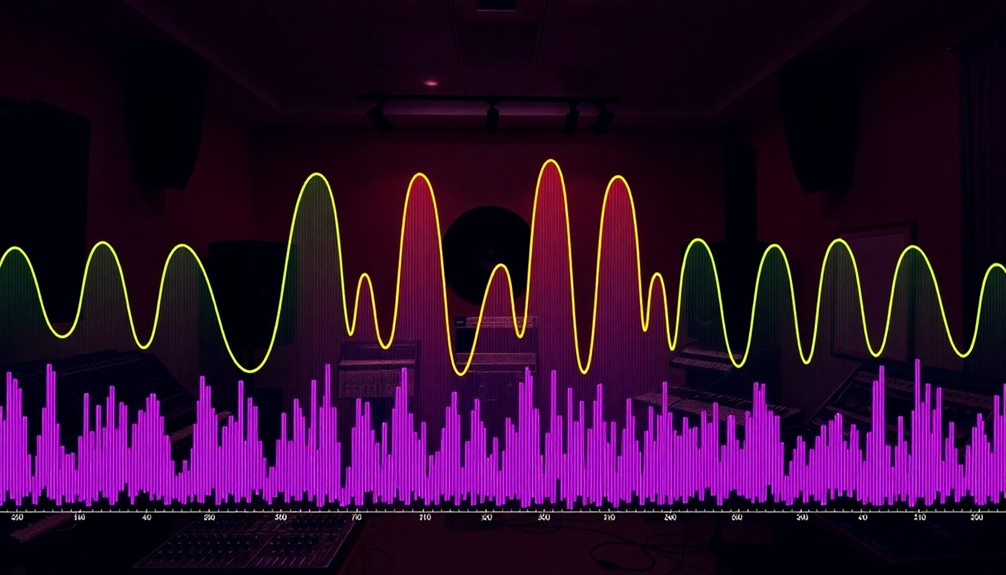
Leveraging the Fletcher-Munson effect can dramatically enhance your audio mixing and mastering processes. This knowledge helps you understand how your listeners perceive sound, making your work shine!
Here are some practical applications you can use:
- Focus on Vocals and Snares: Since our ears are super sensitive to 2kHz to 4kHz, make sure these elements stand out in your mix without being too loud.
- Adjust Low and High Frequencies: Remember, low and high frequencies need more power to sound the same as mid-range sounds. Keep this in mind when mixing!
- Set Ideal Listening Levels: For long mixing sessions, aim for around 90 dB SPL. This level helps achieve a balanced sound that's easier on the ears.
- Enhance Sound Design: Use the Fletcher-Munson curve to tailor your sound systems and hearing aids. By matching frequency needs to human hearing, you create a better listening experience.
Human Hearing and Frequency Sensitivity

Human hearing is a complex and fascinating process, especially when it comes to how we perceive different frequencies. Did you know that our ears are most sensitive to sounds between 2 kHz and 4 kHz? This range is where human speech lies, making it super important for understanding each other.
The cochlea, a tiny spiral-shaped part of your inner ear, helps us with this. Inside, there are hair cells that respond to different frequencies in a special way.
When it comes to low frequencies, like bass sounds, your ears need more power to hear them as loudly as mid-range sounds. In fact, you might need about 19 dB more power for those deep tones!
On the other hand, as you listen to louder sounds, the perception of both low and high frequencies changes. This is where the Fletcher-Munson curves come into play, showing how loudness varies across frequencies.
Everyone's ears are a bit different, which means how loudly you hear things can vary from person to person. Understanding these differences in human hearing helps sound designers create better music and audio experiences for all of us!
Importance of Volume Levels

Volume levels play a significant role in how we perceive sound, particularly when it comes to the Fletcher-Munson effect. When you listen to music at different volumes, your ears react differently to frequencies. At lower volume levels, you might notice that the bass and treble seem quieter. This leads to a flatter sound that can be less enjoyable.
Here are some key points to remember:
- Low Volume: You may not hear low and high frequencies well, making music sound dull.
- Mid Volume: Your ears become more sensitive to midrange sounds, like vocals and snare drums, which pop out!
- High Volume: Everything sounds lively, but be careful! Too loud can hurt your ears.
- Recommended Level: Mixing at around 90 dB SPL helps guarantee you can perceive all frequencies nicely.
Understanding these volume levels helps you enjoy music more fully.
Implications for Music Production
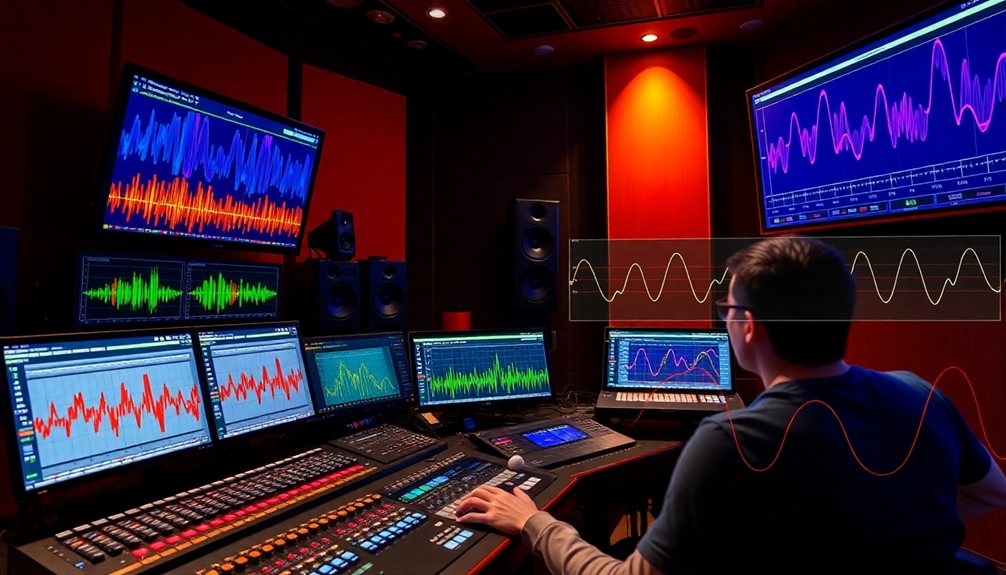
Understanding the Fletcher-Munson effect is vital for music production, as it directly influences how you mix and master tracks. This fascinating science behind sound shows that our ears are most sensitive to frequencies between 2kHz and 4kHz. This range is significant because it's where important elements like vocals and snare drums often sit.
When you're mixing, you need to balance these sounds to prevent them from overpowering the rest of the music. It's also important to take into account listening volume. At lower volumes, you might notice mid-range sounds more, while higher volumes bring out both low and high frequencies. This can change how your mix sounds in different environments.
Being aware of how listeners perceive sound helps you make smarter decisions about EQ settings and dynamic range. You want to create tonal balance that works across various playback systems.
Plus, using loudness units like LUFS during mastering can guarantee your tracks maintain a consistent perceived loudness. By understanding the Fletcher-Munson effect, you'll make your music shine, sounding great no matter where it's played!
Tips for Effective Mixing Strategies
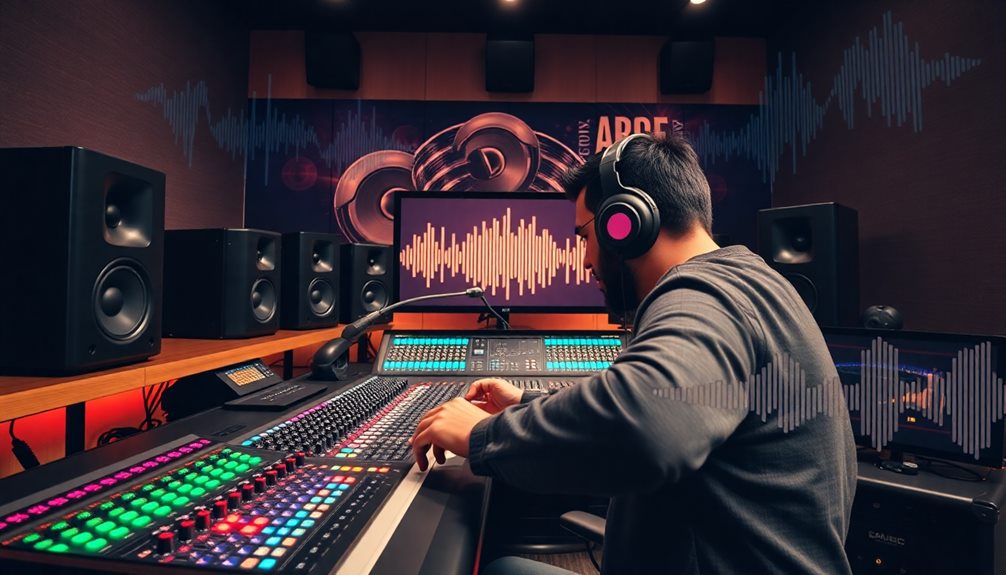
Effective mixing strategies hinge on recognizing the nuances of sound perception, particularly influenced by the Fletcher-Munson effect. By understanding how your ears and brain perceive sound at different volumes, you can create a mix that truly shines. Here are some tips to help you mix effectively:
- Focus on 2kHz to 4kHz: This frequency range is where our hearing is most sensitive. Make sure to balance vocals and snares here so they don't overpower the mix.
- Consider the Listening Environment: Mixing ambient music for quiet settings is different from mixing dance tracks for clubs. Higher volumes emphasize bass, so adjust accordingly.
- Use the Fletcher-Munson Curve: This guideline helps you understand how loudness perception changes. At lower volumes, mid-range sounds stand out, while lows and highs become more prominent as volume increases.
- Monitor Your Sound Levels: Use a decibel meter or app to keep your mixing level around 90dBSPL. This helps maintain hearing health and accurate sound perception.
Frequently Asked Questions
What Does the Fletcher Munson Curve Tell Us?
The Fletcher-Munson Curve shows how you perceive loudness across different frequencies. It reveals that mid-range sounds seem louder at lower volumes, while low and high frequencies need more power to achieve the same perception.
What Is the Fletcher Munson Phenomenon?
You won't believe how your ears play tricks on you! The Fletcher-Munson phenomenon reveals that our sensitivity to sound varies with volume, making certain frequencies seem louder or softer depending on the sound pressure levels.
What Do the Fletcher Munson Equal Loudness Curves Reveal About the Nature of Human Hearing?
The Fletcher-Munson equal loudness curves reveal that your ears perceive loudness differently across frequencies. You're most sensitive to mid-range sounds, needing higher volume for low and high frequencies to feel equally loud.
What Is the Frequency That Human Ears Hear the Best According to the Fletcher Munson Curve?
You'll find that human ears hear best between 2 kHz and 4 kHz. This range is where your perception of loudness peaks, making it essential for clarity in both speech and music.
Conclusion
In the end, understanding the Fletcher-Munson effect can truly transform how you enjoy and create music. It's like having a secret map that guides you through the vibrant world of sound! By keeping volume levels in mind and using smart mixing techniques, you can make your music shine brighter than ever. So, grab your headphones, turn up the joy, and let those beats take you on a fantastic journey! Happy mixing!
